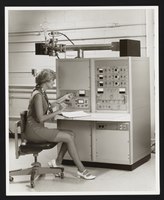
Photo from wikipedia
Data independent acquisition–mass spectrometry (DIA–MS) is becoming widely utilised for robust and accurate quantification of samples in quantitative proteomics. Here, we describe the systematic evaluation of the effects of DIA… Click to show full abstract
Data independent acquisition–mass spectrometry (DIA–MS) is becoming widely utilised for robust and accurate quantification of samples in quantitative proteomics. Here, we describe the systematic evaluation of the effects of DIA precursor mass range on total protein identification and quantification. We show that a narrow mass range of precursors (~250 m/z) for DIA–MS enables a higher number of protein identifications. Subsequent application of DIA with narrow precursor range (from 400 to 650 m/z) on an Arabidopsis sample with spike-in known proteins identified 34.7% more proteins than in conventional DIA (cDIA) with a wide precursor range of 400–1200 m/z. When combining several DIA–MS analyses with narrow precursor ranges (i.e., 400–650, 650–900 and 900–1200 m/z), we were able to quantify 10,099 protein groups with a median coefficient of variation of <6%. These findings represent a 54.7% increase in the number of proteins quantified than with cDIA analysis. This is particularly important for low abundance proteins, as exemplified by the six-protein mix spike-in. In cDIA only five out of the six-protein mix were quantified while our approach allowed accurate quantitation of all six proteins.
Journal Title: Life
Year Published: 2021
Link to full text (if available)
Share on Social Media: Sign Up to like & get
recommendations!